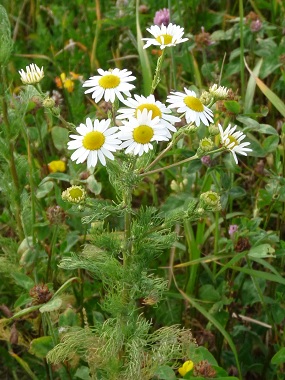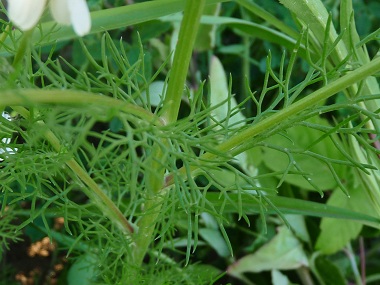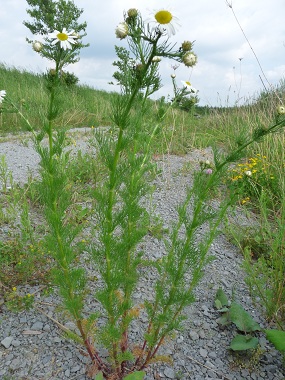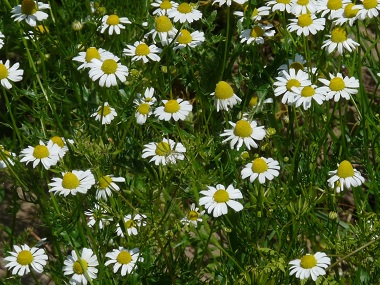






To support our efforts please browse our store (books with health benefits, etc.).
Chamomile is definitely one of the most popular wild medicinal plants that can be eaten. The two main types are the more popular German chamomile and the lesser known Roman chamomile (Chamaemelum nobile). Although they belong to different species, they are used to treat the same health ailments in herbal pharmacy. Both are used to calm frayed nerves, help in soothing various stomach problems, reduce muscle spasms, and to treat several skin conditions. The German variety grows in many countries.
Distinguishing Features
Chamomile is an annual wild edible that is easily recognized by its tiny daisy-like flowers (measuring no more than 2.5 centimetres wide). For the German variety there is only one flower that grows on a solitary stem.
Flowers
Chamomile flowers resemble daisy flowers, with white petals circling a cone-shaped yellow centre. Depending on conditions, these flowers bloom between May and October.
 Fields
of Nutrition has medicinal benefits and vitamin/mineral content of Chamomile.
Fields
of Nutrition has medicinal benefits and vitamin/mineral content of Chamomile.
Leaves
German chamomile leaves are fern-like light green and feathery whereas the Roman variety has finely divided parsley-like leaves that are thicker and flatter than their German equivalents.
Height
Chamomile, depending on conditions, can grow to anywhere from 60 centimetres to 1 metre tall.
Habitat
German chamomile does well in poor, clay soil whereas the Roman variety prefers well-drained and moderately fertile soil. Although both varieties thrive in open, sunny locations, Roman chamomile will not tolerate hot, dry weather. German chamomile will also grow in lightly-shaded areas.
Edible Parts
The leaves and flowers are both edible but they differ in taste (the flowers have a slight apple taste). Both can be tossed into a salad or a mug to make a fresh herbal tea.
Other Name
German Chamomile.
Similar Plants
Roman Chamomile.
Winter Survival Food Handbook

PDF Plant Magazines
Types of Wild Food
Geographic Zones Seasons
Disclaimer
EdibleWildFood.com is informational in nature. While we strive to be 100% accurate, it is solely up to the reader to ensure proper plant identification. Some wild plants are poisonous or can have serious adverse health effects.
We are not health professionals, medical doctors, nor are we nutritionists. It is up to the reader to verify nutritional information and health benefits with qualified professionals for all edible plants listed in this web site. Please click here for more information.
Why Edible Wild Food?
- Food costs are rising
- Free, wild food is readily abundant
- Wild food adds nutrition to your diet
- Wild food can help treat various medical conditions







